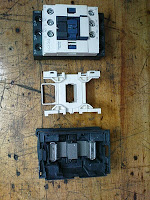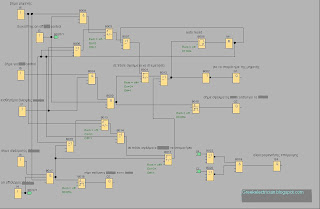 |
| inverter circuit |
The three-phase motor, which is the first choice for many applications have their speed directly dependent on the frequency of the power supply.
Everywhere on earth, the frequency is determined and fixed by the provider and can not be selected
The only satisfactory way to test the speed is via inverter.
The inverter "reverses" (invert) the voltage, makes controlled AC rms and frequency.
The technique of creating alternating voltage constant, which is usually selected by the manufacturers of inverters,is the PWM (Phase Width Modulation)
The DC voltage they need is making from the alternating supply with single-phase or three-phase bridge rectifier.
The basic design operating an inverter shown.
As switches data, T1 to T6, used fast response power transistors. The diodes D1 to D6, which are free-flow passages are also fast response and is to protect the transistor.
 |
| Schneider-phase inverter
|
There are in-phase inverter market is small triphasic motors, three-phase inverter and intended for larger motors.
The characterization of single phase or three phase, indicating loading it, if we have a single-phase input voltage of 230 volts for Greece, or three-phase 400 volts. And also identify the maximum rms value of the output voltage can give, ie 230 volts to 400 volts single phase and three phase for.
The operating parameters of the inverter varies with the brand, the size of their power and capabilities and "passed" to memory by either the panel with the display having, or several models, through PC.
The main parameters include acceleration time (how many seconds from startup reaches the selected speed - frequency), time delay (in number of seconds the command will stop reaches the minimum allowable frequency before stopping), the minimum and maximum operating frequency , setting a maximum output current and thermal power.
 |
| Under the lid of inverter |
Because of the way creating the alternating voltage, fragmentation of continuous electronic switches with large frequencies (approximately 5 to 20 KHz selected via parameter) there are unwanted harmonic frequencies as they are called, which are multiples of the frequency of fragmentation.
In motor controlled by inverter there is the disadvantage of unnecessary "movement" of these harmonic currents that generate unwanted heat pipes and can in some cases the energy waste is measurable and relatively large example in large industries.
The cable from the inverter to the motor must be grounded conductive mantle, that is, blentaz, as they say, because the frequencies of the harmonics are such as electromagnetic pulse transmitted by "parasites" in adjacent circuits and certainly not good for man .
 |
| Three-phase inverter yaskawa brand
|
The motor controlled by inverter must have good ventilation at low speeds because there is adequate ventilation by their own cooling fans.
If it works then at low revs must enter separate cooling fan. There are specially designed motor with higher heat dissipation surfaces specifically to be driven by inverter.
Air conditioners with inverter control the speed of the compressor motor freon according to the temperature setting and not the maximum speed of the motor, as it would be if they had the inverter, thus achieving a better result and economy.




























